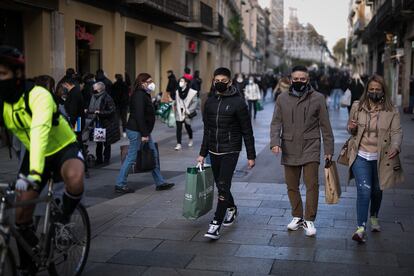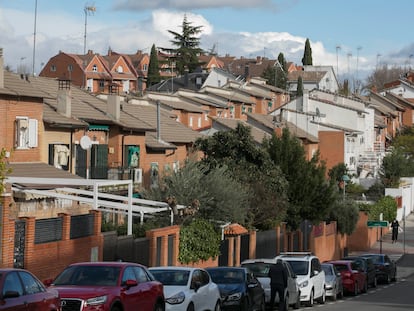Spain’s coronavirus incidence rate continues to rise, nearing 200 cases per 100,000 inhabitants
The Spanish Health Ministry reported 10,328 new infections on Tuesday and added 388 deaths to the official toll

The incidence rate of the coronavirus in Spain has risen for the third day in a row. According to the Health Ministry report, released Tuesday evening, the 14-day cumulative number of coronavirus cases per 100,000 now stands at 198.77, up from 193.6 on Monday (which covers figures from Saturday and Sunday) and 189 on Friday. Up until Friday, the coronavirus incidence rate had been on a downward trend for five consecutive weeks. According to the latest Health Ministry report, 10,328 new coronavirus cases were detected on Tuesday and added 388 Covid-19-related deaths to the official toll.
It is still too soon to consider whether these figures indicate an upward trend, according to epidemiologist Pedro Gullón, who explained that delays in notifications due to recent public holidays – data is often released later due to staff shortages on holidays and weekends – may be responsible for the rise in cases. It is also too soon to attribute the rise to last week’s long weekend as contagions are not typically reflected in the figures until 10 days after they happen.
The Inter-Territorial Council of the National Health System must decide whether it should toughen the coronavirus restrictions for the festive season
How the pandemic evolves this week will be key to determining the direction of the epidemiological curve and to what extent it has been affected by the recent public holidays. It will be important to determine this given that the Christmas holidays are fast approaching and the Inter-Territorial Council of the National Health System, which brings together central and regional healthcare chiefs, must decide whether it should toughen its coronavirus restrictions for the festive season. Fernando Simón, the director of the Health Ministry’s Coordination Center for Health Alerts (CCAES), said on Monday that the measures – which include a 1.30am curfew for Christmas Eve and New Year’s Eve, and a six-person limit on social gatherings – will remain in place, but could be adapted if needed. Authorities in the Balearic Islands and the Canary Islands, which have reported the biggest rise in coronavirus cases, have already announced tougher restrictions for the Christmas holiday period.
The rise in cases is not clearly reflected in the number of hospitalizations for Covid-19, which is considered one of the most accurate measures of the health crisis. The hospital occupation rate is also one of the most important data points when it comes to making decisions: when medical centers become overwhelmed, sweeping action must be taken so that new cases can be attended to. Although the occupation rate rose slightly on Monday, it fell again on Tuesday. According to the latest report, Covid-19 patients occupy 9.6% of all hospital beds in Spain. The occupation rate in intensive care units (ICUs) also continues to slowly fall and now stands at 21.51%.
With respect to the situation in Spain’s regions, the Balearic Islands, which until a few days ago had the second-best epidemiological data in the country, now has the highest incidence rate: 291 cases per 100,000 inhabitants. The Canary Islands has the lowest incidence rate, but the figure has risen to 117. Eight other regions also reported a rise in the 14-day cumulative number of cases per 100,000 inhabitants with respect to Monday’s figure: the Valencia region, the Balearic Islands, Castilla-La Mancha, Madrid, Catalonia, Navarre, Galicia, Murcia, as well as the North African exclave cities of Ceuta and Melilla. The incidence rate fell in the remaining regions.
English version by Melissa Kitson.
Tu suscripción se está usando en otro dispositivo
¿Quieres añadir otro usuario a tu suscripción?
Si continúas leyendo en este dispositivo, no se podrá leer en el otro.
FlechaTu suscripción se está usando en otro dispositivo y solo puedes acceder a EL PAÍS desde un dispositivo a la vez.
Si quieres compartir tu cuenta, cambia tu suscripción a la modalidad Premium, así podrás añadir otro usuario. Cada uno accederá con su propia cuenta de email, lo que os permitirá personalizar vuestra experiencia en EL PAÍS.
¿Tienes una suscripción de empresa? Accede aquí para contratar más cuentas.
En el caso de no saber quién está usando tu cuenta, te recomendamos cambiar tu contraseña aquí.
Si decides continuar compartiendo tu cuenta, este mensaje se mostrará en tu dispositivo y en el de la otra persona que está usando tu cuenta de forma indefinida, afectando a tu experiencia de lectura. Puedes consultar aquí los términos y condiciones de la suscripción digital.
More information
Últimas noticias
Most viewed
- Oona Chaplin: ‘I told James Cameron that I was living in a treehouse and starting a permaculture project with a friend’
- Sinaloa Cartel war is taking its toll on Los Chapitos
- Reinhard Genzel, Nobel laureate in physics: ‘One-minute videos will never give you the truth’
- Why the price of coffee has skyrocketed: from Brazilian plantations to specialty coffee houses
- Silver prices are going crazy: This is what’s fueling the rally











































